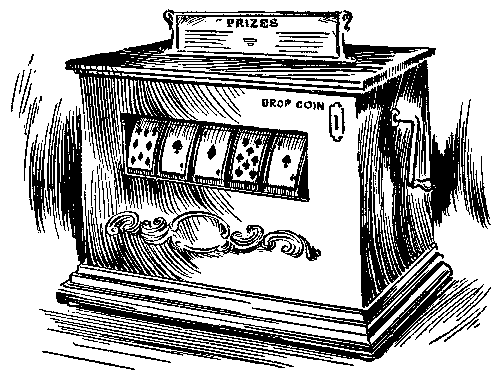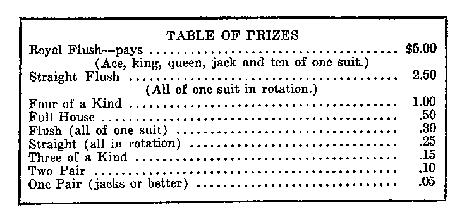
NOTE! This material is from 1946 about mechanical slot machines. Modern electronic slot machines work differently.

There are thirty or forty different makes of gambling slot machines in existence. A classification of them would read like a catalog. They are set strong against the players and their construction is all in favor of the owner.
The slot machines that get the biggest play are those which take a nickel. The player drops the coin in a slot, pulls a handle and wheels revolve. In stopping they form different combinations which pay the player various sums--and sometimes nothing.
The machines that are most popular deliver the money automatically. Sometimes they are played with checks or slugs which the player trades in for cash.
There is no need to go into the details of the mechanism of the usual nickel slot machine. It has supplanted many of the other machines and its mechanical opperation and the percentages on the wheel favor the owner of the machine to an enormous degree. A man will buy a hundred-dollar machine and run it in violation of the law. If he gets away with it for a few weeks he doesn't worry if the machine is grabbed. He will have a big profit and enough over to buy a new machine.
Slot machines are the most ingenious of mechanical gambling devices. The player cannot see the interior and he plays it blindly. Why men of common sense will fritter away their cash on games like there is hard to tell. The more they play the more they lose.
When you play a slot machine the odds are not only against you, but the machine probably has much more money in it than you have in your pocket. A loss of twenty dollars may break the player, but it would take much more than that to break the machine and then the owner would put in more money. Once the machine gets ahead of the game it is finis for the player. He is bucking a game that has been devised to trim him.
But remember, this is not method to beat a slot machine. There is no system that will bring results. A player may win a few dollars at the most. He is foolish even to play the game. The average person loses his head when he gets ahead of the game and won't quit. Once he is behind he keeps on playing to regain his losses. Plenty of pay envelopes have been emptied into slot machines. They are the greatest form of sucker bait ever invented.


In the first place, the player is misled. He thinks he is working on a straight poker basis with a chance of any possible combination. Now naturally the machine would not be made so that two identical cards would appear at once--on different wheels. There are just fifty-two cards in a pack, and these must be distributed among five wheels--that is, about ten different cards to each wheel.
The picture with the rows of cards [below] shows how this can be done. Each vertical row represents a different wheel. It will be noted that, while cards are duplicated on the same wheel, no card appears on more than one wheel.
 |
Poker Slot Machine. Each vertical run is curved to form a wheel. Study the arrangement of the cards and you will see that many of the large winning combinations are impossible to attain. Straight flushes are eliminated--and only one Four of a kind can possibly appear. |
|---|
Look for a straight flush. You will find that it is also impossible with this layout. Where are the four aces? Two different aces appear on one wheel. That eliminates four aces. Most of the possible combinations of four of a kind are completely out of the picture, although it is possible.
Full houses are hard to make, and flushes are not easy. Look at spades, for example. The ace is the only spade on one wheel. In order to make a flush in spades that one particular card must appear. The possibilities of a flush in any other suit are also limited.
The player has a chance for some of the small prizes, but the percentage is greatly against him. He would be wise enough not to risk his money for the little prizes. What he is after is the big rewards, which he can never get.
As the mechanism is not on view the unthinking player does not realize what he is up against. During the course of many plays he will see practically every card in the pack. He will not note which wheel each one is on and he will think the machine is a fair one.
In order to make these machines legal they are often introduced as vending machines, along side of each machine is a container that delivers packages of mints--a package for each nickel. The candy resembles regular five cent packages, but it is of a cheap grade. The man who owns the machine can let the mints go--his profits are big enough. This should convince some of the suckers that they are in wrong, but it doesn't.
Players seldom pay any attention to the mints as they are after money--not candy. So the latest model machines deliver mints on every play automatically, to prove that they are not gambling devices. The players get plenty of candy and the machines take in the money. If you try to beat one of these machines, carry a suitcase. All you will get is candy and you might as well bring it home as a souvenir.
[See this example of a "Liberty
Bell" slot machine. It dispenses a gumball with each play.
Example of a
Liberty Bell token used in similar slot machines.]
Naturally, when a player approached the machine he would see the figure 0 showing, which would mean that he would lose his nickel. But what he wanted to see was the next number, which might be a winner. So he would waste his first nickel. Every time 0 would show up he would take another chance. If a number like 5 (meaning five nickels or twenty-five cents) would appear, he would lose no time in getting after it.
Just think this over. When a machine can be so constructed that it will tell the number that is going to appear before a nickel is dropped in, should any sane person believe that machine to be on the level? If it can tell one ahead, why not two, three, four, five or any number of successive plays? Yet these slot machines, which were legal in certain localities, did the biggest business in the history of the game. All of which proves that when Barnum said "There is one born every minute" he made a very conservative estimate.
Return to main page